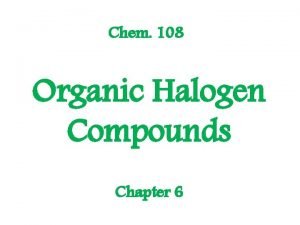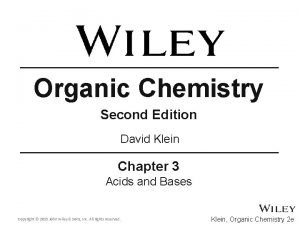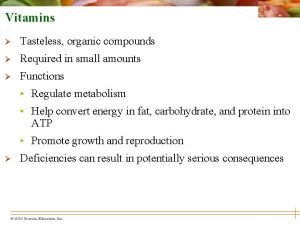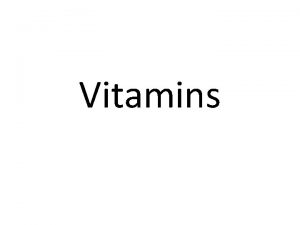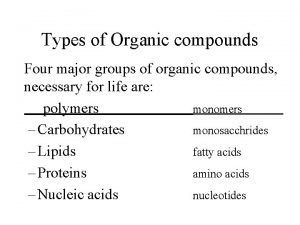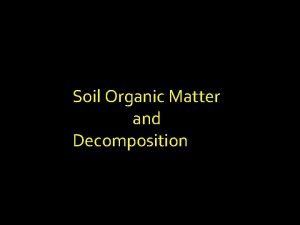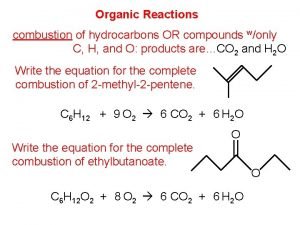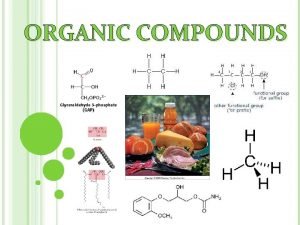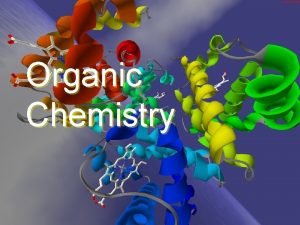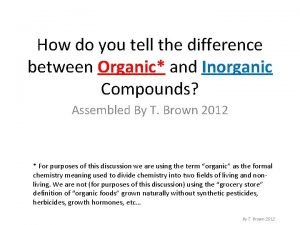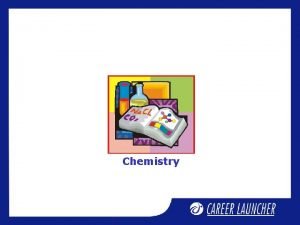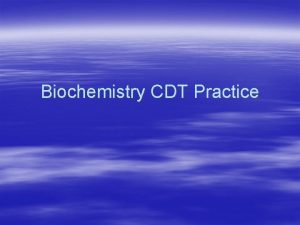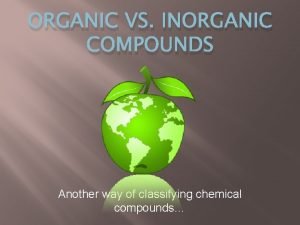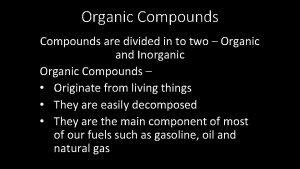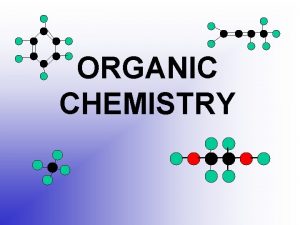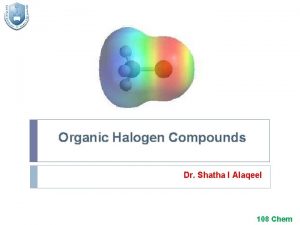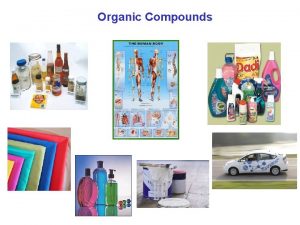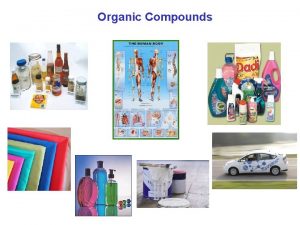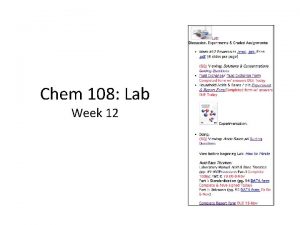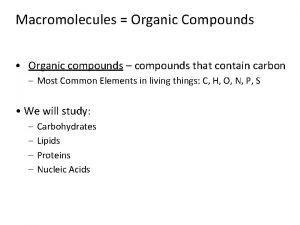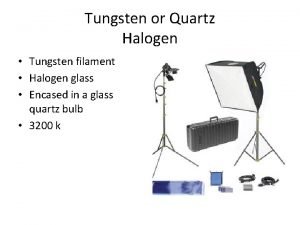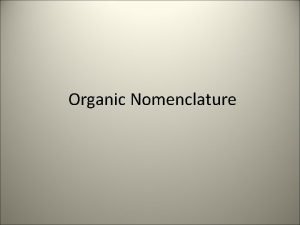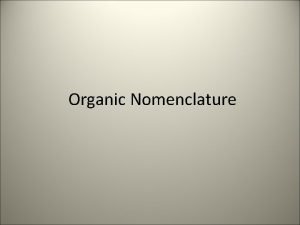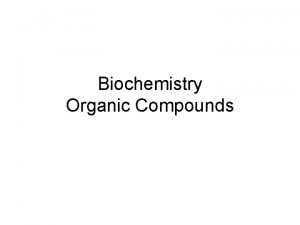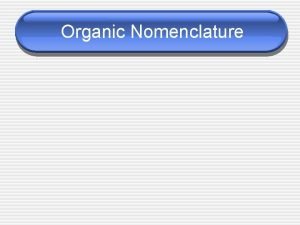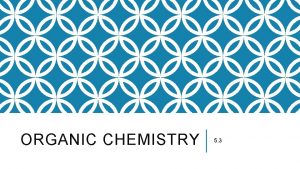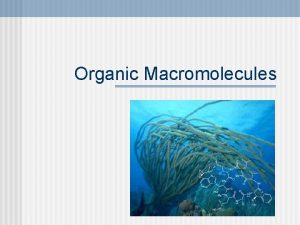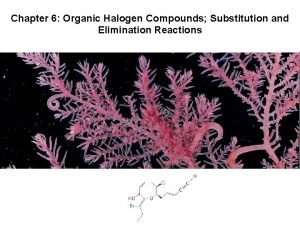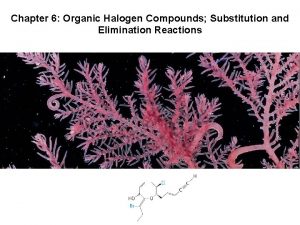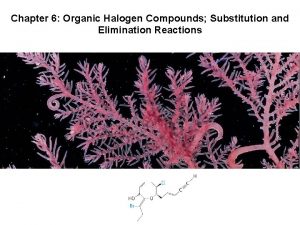Chem 108 Organic Halogen Compounds Chapter 6 Organic






















- Slides: 22

Chem. 108 Organic Halogen Compounds Chapter 6

Organic Halogen Compounds q An organic compound containing at least one carbon-halogen bond (C-X) § X (F, Cl, Br, I) replaces H q Can contain many C-X bonds Classes and Names of Halogen Compounds 1 - Alkyl halides, R-X A compound containing a halogen covalently bonded to an sp 3 hybridized carbon. q Alkyl halides are subdivided into primary (1°), secondary (2°), or tertiary (3°), depending on the type of carbon to which the halogen is attached. q

Examples:

2 - Vinylic halides, C=C-X A compound containing a halogen bonded to an sp 2 hybridized carbon. 1 -Chlorocyclobutene 3 - Allylic halides, C=C-C-X A compound containing a halogen bonded to an sp 3 hybridized carbon next to doubly bonded carbon C=C.

4 - Aryl halides, Ar-X A compound containing a halogen bonded to an aromatic ring. 5 - Benzylic halides, Ar-C-X A compound containing a halogen bonded to an sp 3 hybridized carbon next to an aromatic ring.

6 - Polyhalogens q Haloalkane and Haloarene can be classified on the basis of number of Halogen atoms. q They maybe classified as mono, di-, tri-, tetra-, …etc atoms in their structure.

q Common names of alkyl halides are used only. Examples:

Nomenclature of Halogen Compounds

Physical Properties of Halogen Compounds 1 - Solubility All organic halides are soluble in the nonpolar solvents such as carbon tetrachloride (CCl 4) and benzene (C 6 H 6), but they are insoluble in polar solvents such as water.

2 - The boiling point of the organic halides increase, as the size of the halogen increase. The boiling point also increase regularly with molecular weight. As expected, within a series of isomers, the straight-chain compounds has the highest boiling points, and the most branched isomer the lowest boiling point.

Preparation of Halogen Compounds A Chloro, Bromo, and Iodo Compounds 1. Direct Halogenation of Hydrocarbons (a) Halogenation of alkanes: alkyl halides (b) Halogenation of alkenes

(c) Halogenation of alkynes (d) Halogenation of aromatic ring and alkyl benzenes

2. Addition of HX to Unsaturated Hydrocarbons (a) Addition of HX to alkenes: (b) Addition of HX to alkynes:

3. Conversion of Alcohols: The hydroxyl group of an alcohol is replaced by halogen on reaction with concentrated halogen acid (HX), phosphorus halides (PX 3 or PX 5), and thionylchlorid (SOCl 2).

Reactions of Halogen Compounds q Nucleophilic substitution reactions (SN ) q Elimination reactions ( E ) q Reaction with certain metals to form Organometallic compounds 1 - Nucleophilic substitution reactions ( SN ) Examples of Common Nucleophiles:


Examples:

2 - Elimination reactions ( E )

Common basis used in dehydrohalogenation Examples: + 10 % 90 % + 90 % 10 %

3 - Reaction with certain metals to form Organometallic compounds A- Reduction with Mg and Zn Grignard Reaction

B- Reduction with alkali metals ( Li, Na, or K) Wurtz Reaction Corey-House (Gilman reagent)

Homework 1 - Write the structure and name the following compounds according to the IUPAC system. a. Bromoform b. Vinyl bromide c. t. Butyl iodide d. Allyl chloride 2 - Complete the following reactions.
 Organic halogen compounds
Organic halogen compounds Obtuse
Obtuse Pvifad
Pvifad Meth eth prop but table
Meth eth prop but table Ario acronym chemistry
Ario acronym chemistry Ionic covalent and metallic bonds venn diagram
Ionic covalent and metallic bonds venn diagram Water soluble vitamins absorption
Water soluble vitamins absorption Vitamin classification chart
Vitamin classification chart The four major groups of organic compounds are
The four major groups of organic compounds are Decomposition of organic matter equation
Decomposition of organic matter equation Charring test of organic and inorganic compounds
Charring test of organic and inorganic compounds Organic combustion reaction
Organic combustion reaction Organic compound made by living things
Organic compound made by living things All organic compounds must contain the element
All organic compounds must contain the element Organic compounds must contain
Organic compounds must contain Priority order of functional groups
Priority order of functional groups Organic chemistry chapter 1
Organic chemistry chapter 1 What is the difference between organic and inorganic
What is the difference between organic and inorganic Purification and characterization of organic compounds
Purification and characterization of organic compounds Organic compounds such as proteins and starches are too
Organic compounds such as proteins and starches are too Organic vs inorganic compounds
Organic vs inorganic compounds What is the classification of organic compounds
What is the classification of organic compounds Group of carbon
Group of carbon
